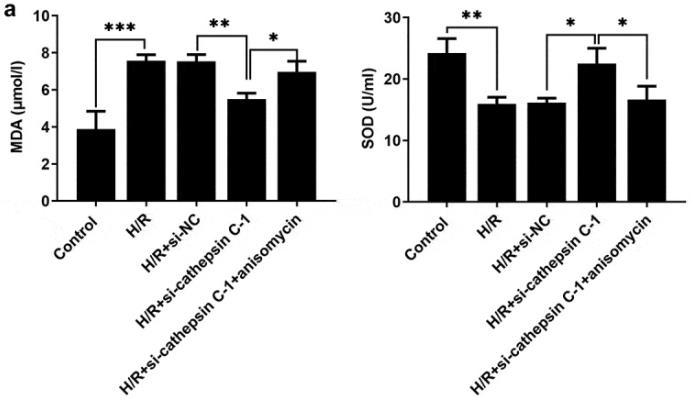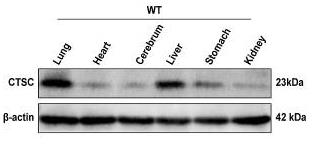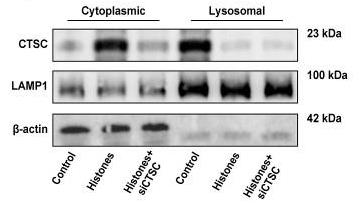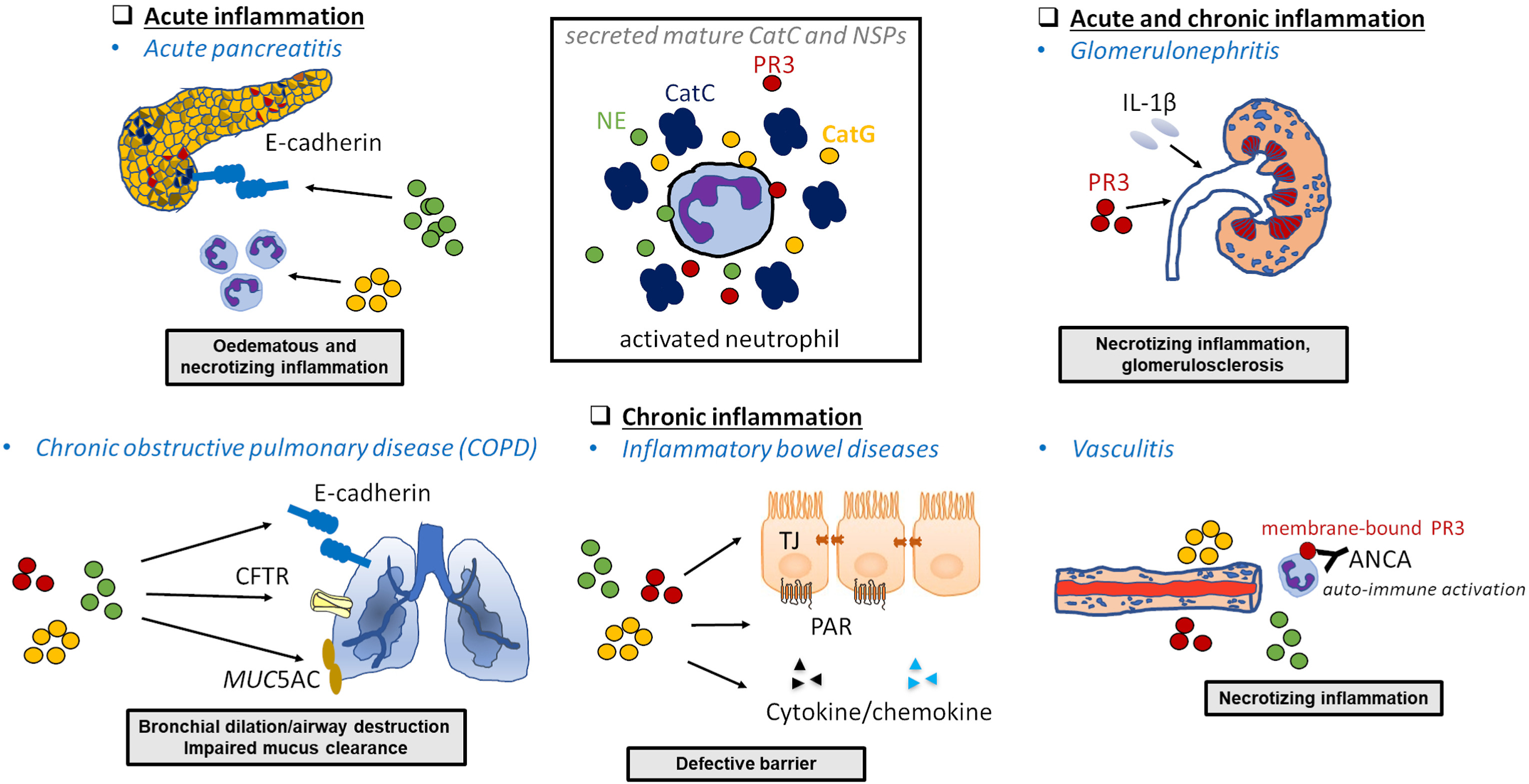Recombinant Human CTSC protein(Asp 25 - Leu 463), His-tagged
| Cat.No. : | CTSC-2509H |
| Product Overview : | Recombinant Human CTSC protein(Asp 25 - Leu 463)(P53634-1), fused with C-terminal His tag, was expressed in HEK293. |
| Availability | April 02, 2025 |
| Unit | |
| Price | |
| Qty |
- Specification
- Gene Information
- Related Products
- Case Study
- Application
- Download
| Species : | Human |
| Source : | HEK293 |
| Tag : | His |
| Protein Length : | Asp 25 - Leu 463 |
| Form : | Supplied as 0.2 μm filtered solution in 12.5 mM MES, 75 mM NaCl, pH6.5 with glycerol as protectant. |
| Bio-activity : | Measured by its ability to cleave the fluorogenic peptide substrate, Gly-Arg-7-amido-4-methylcoumarin (GRAMC). The specific activity is >5000 pmol/min/μg. |
| Molecular Mass : | The protein has a calculated MW of 51.4 kDa. The protein migrates as 60-65 kDa when calibrated against Star Ribbon Pre-stained Protein Marker under reducing (R) condition (SDS-PAGE) due to glycosylation. |
| Endotoxin : | Less than 1.0 EU per ug by the LAL method. |
| Purity : | >95% as determined by SDS-PAGE. >90% as determined by SEC-MALS. |
| Storage : | For long term storage, the product should be stored at lyophilized state at -20°C or lower. Please avoid repeated freeze-thaw cycles. This product is stable after storage at: -20°C to -70°C for 12 months in lyophilized state; -70°C for 3 months under sterile conditions after reconstitution. |
| Reconstitution : | It is recommended that sterile water be added to the vial to prepare a stock solution of 0.2 ug/ul. Centrifuge the vial at 4°C before opening to recover the entire contents. |
| Gene Name | CTSC cathepsin C [ Homo sapiens ] |
| Official Symbol | CTSC |
| Synonyms | CTSC; cathepsin C; PALS, PLS; dipeptidyl peptidase 1; DPP1; cathepsin J; dipeptidyl peptidase I; dipeptidyl transferase; dipeptidyl-peptidase I; JP; HMS; JPD; PLS; CPPI; DPPI; PALS; DPP-I; |
| Gene ID | 1075 |
| mRNA Refseq | NM_001114173 |
| Protein Refseq | NP_001107645 |
| MIM | 602365 |
| UniProt ID | P53634 |
| ◆ Recombinant Proteins | ||
| CTSC-2509H | Recombinant Human CTSC protein(Asp 25 - Leu 463), His-tagged | +Inquiry |
| CTSC-912R | Recombinant Rhesus Macaque CTSC Protein, His (Fc)-Avi-tagged | +Inquiry |
| Ctsc-8179M | Recombinant Mouse Ctsc protein, His-tagged | +Inquiry |
| CTSC-176C | Recombinant Cynomolgus Monkey CTSC Protein, His (Fc)-Avi-tagged | +Inquiry |
| CTSC-2510H | Active Recombinant Human CTSC, His-tagged | +Inquiry |
| ◆ Cell & Tissue Lysates | ||
| CTSC-3024HCL | Recombinant Human CTSC cell lysate | +Inquiry |
Case 1: Lu F, et al. Bioengineered. 2022
Cathepsin C, elevated in preeclampsia, activates p38 MAPK/NF-κB signaling, exacerbating endothelial dysfunction. In H/R-injured HUVECs, cathepsin C silencing reduced oxidative stress, improved cell viability, and enhanced angiogenesis by suppressing this pathway, while p38 activation reversed these effects. This highlights cathepsin C’s role in PE pathogenesis via p38/NF-κB-mediated endothelial damage, offering insights for therapeutic targeting.

Fig1. Western blot assay was employed to detect cathepsin C expression.

Fig2. MDA assay kit and SOD assay kit were employed to detect MDA and SOD levels.
Case 2: Yu J, et al. Redox Biol. 2024
In lung ischemia/reperfusion injury, Cathepsin C (CTSC) from alveolar macrophages drives NETosis via NADPH oxidase/ROS and p38 MAPK activation, exacerbating primary graft dysfunction. CTSC enhances membrane proteinase 3 activity, amplifying NET-related inflammation. Targeting CTSC inhibits ROS-driven NETosis, reducing transplant injury. This reveals CTSC’s role in neutrophil extracellular trap formation and offers therapeutic strategies for improving lung transplant outcomes.

Fig1. Protein levels of CTSC in various murine tissues were detected using western blot.

Fig2. Protein levels of CTSC in the cytoplasm and lysosome of MH-S cells treated with extracellular histones and siCTSC.

Fig1. Pro-inflammatory functions of CatC in different acute and chronic diseases. (Ali A Aghdassi, 2024)
Not For Human Consumption!
Inquiry
- Reviews
- Q&As
Ask a Question for All CTSC Products
Required fields are marked with *
My Review for All CTSC Products
Required fields are marked with *
Inquiry Basket


